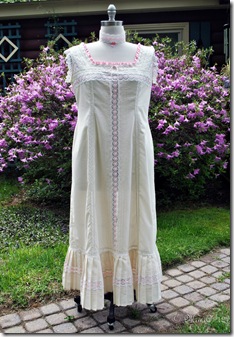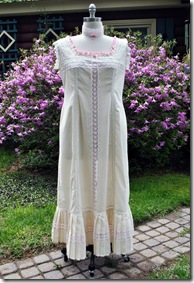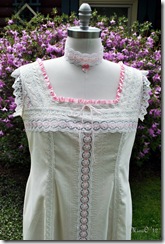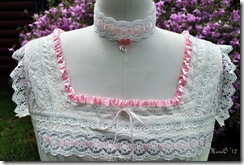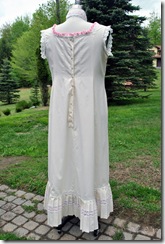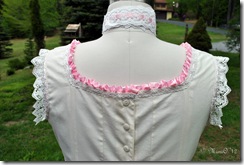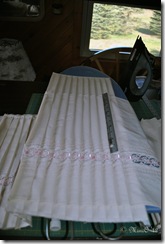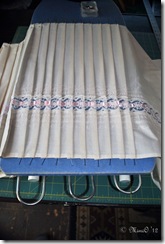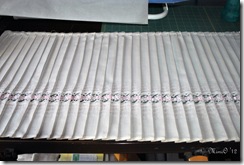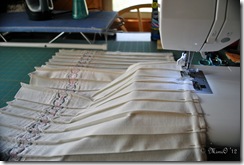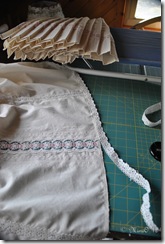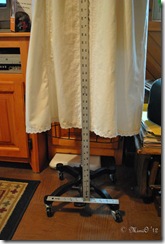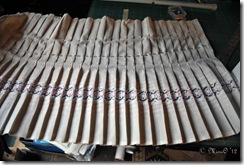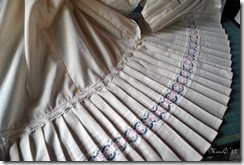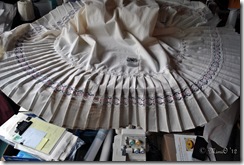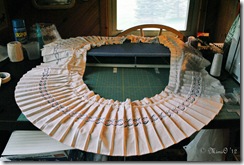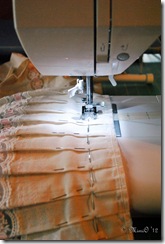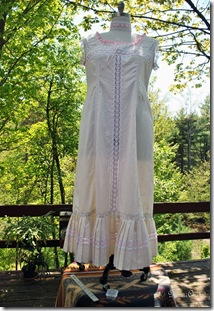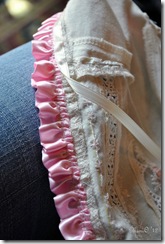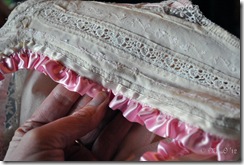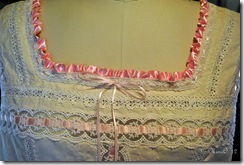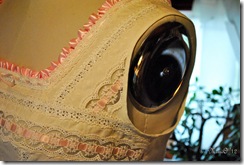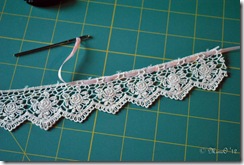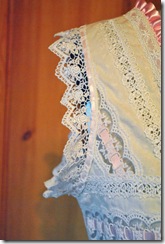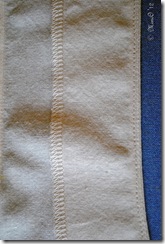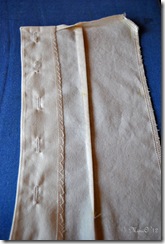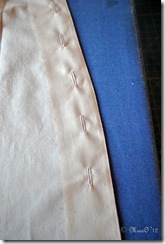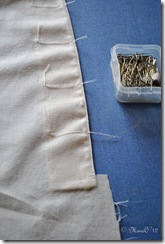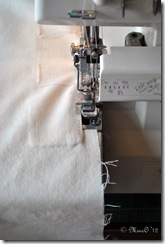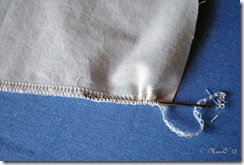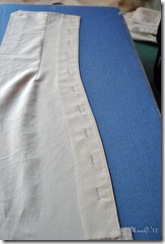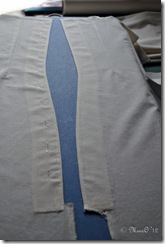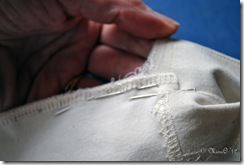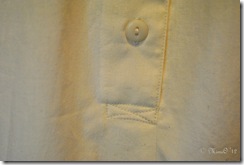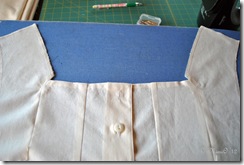Being a lady of modern times I hold no qualms in calling this portion of the 1912 sewing project on the # 0336 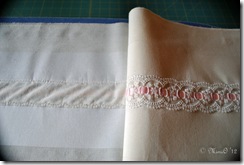 princess slip, The Flounce From Hell. I use this as a term of “endearment”…NOT…for this particular stage in the process of completing my slip.
princess slip, The Flounce From Hell. I use this as a term of “endearment”…NOT…for this particular stage in the process of completing my slip.
As you may recall I mentioned in a previous post that there were TWO moments in this project in which I became completely frustrated and wanted to just run to a corner and cry my eyes out. This is the second one!!!
Things were moving in the right direction. I cut the flounce out according to the directions, stitched one seam together, pressed that open and top-stitched the seams down. I finished off the remaining raw edges with the serger. I installed the 1 1/2” insertion lace and embroidered on both sides of the lace. The tear-away stabilizer was removed, which took a considerable amount of time. Not wanting to accidentally ruin the lace insertion I developed a safe method for clipping open my insertion. Because my lace was 1 1/2” wide I could fit my flat, 12”, metal ruler in between the layers and clip the seams open without any accidental miss-clips into the lace. If you have a narrower lace as your insertion I would
together, pressed that open and top-stitched the seams down. I finished off the remaining raw edges with the serger. I installed the 1 1/2” insertion lace and embroidered on both sides of the lace. The tear-away stabilizer was removed, which took a considerable amount of time. Not wanting to accidentally ruin the lace insertion I developed a safe method for clipping open my insertion. Because my lace was 1 1/2” wide I could fit my flat, 12”, metal ruler in between the layers and clip the seams open without any accidental miss-clips into the lace. If you have a narrower lace as your insertion I would
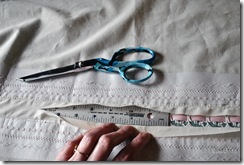
suggest cutting a piece of poster board an 1/8” less and approximately 12” long to slide in between the layers to protect your lace while clipping open.
Here is where things turned horribly wrong. I spent a good portion of one afternoon (4-5 hours) pleating my flounce. I stopped at the half-way point and compared it to my lower slip measurement and was literally crushed to find that it wouldn’t cover the slip measurement. No matter how one figured it out I could not get 1” knife pleats into the flounce and have it match the measurement at the lower slip. Dejected I went back to the drawing board and analyzed my options.
First up…pressing all those pleats out and hoping they wouldn’t show too badly once the flounce was pleated again. One just has to sit there and shake their head at such a goof!!! Second, I hopped online and checked pleating out and discovered that I would NEVER have enough flounce for 1” knife pleats given the cutting requirements the pattern gave you; for one pleat I would need three inches of fabric in order to pleat the flounce as I’d like. My recommendation to future participants that want to sew this slip is to make the upper portion of the slip first and once complete, measure the lower edge where your flounce will be sewn. Once you have that figure add 3” and then multiply that figure by 3. This should give you enough flounce for 1” knife pleats to match your lower slip edge plus a little extra to close the seam.
In trying to dig myself out of this dilemma I had considered cutting another length of flounce to add on to give me the required measurement I’d needed for 1” knife pleats but sadly I did not have enough of my insertion lace. I finally settled on taking 1/2” pleats with a distance of one inch between the folded edge of the pleats. Not exactly the look I wanted but it would have to suffice.
Next…I was NOT going back to sitting and pinning the pleats on my ironing board again. Over a two hour period I created 24” wide pleating board. Below are some pictures of the process.
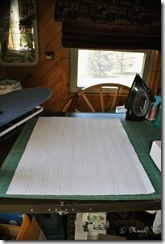 A quickie explanation. I purchased some heavy, fusible craft interfacing meant for bags. I marked off the lines for my pleats in pencil and then fused the fabric to some muslin. I then stitched along my penciled lines which will help you when you go to fold your pleats. I folded the pleats, pressed firmly and then stitched on the outside edges to keep the pleats in place. I cut a piece of poster board the measurement of my finished pleating board. I sprayed adhesive to one side of the board and covered that with some muslin folding the raw edges over to the wrong side. I then sprayed the wrong side of the board and very, carefully pressed my pleated piece onto the board and smoothed it out. Viola….instant pleating board. It wasn’t perfect but made it a lot easier to pleat the flounce. Added bonus…the adjectives that were flying furiously earlier were now few and far between.
A quickie explanation. I purchased some heavy, fusible craft interfacing meant for bags. I marked off the lines for my pleats in pencil and then fused the fabric to some muslin. I then stitched along my penciled lines which will help you when you go to fold your pleats. I folded the pleats, pressed firmly and then stitched on the outside edges to keep the pleats in place. I cut a piece of poster board the measurement of my finished pleating board. I sprayed adhesive to one side of the board and covered that with some muslin folding the raw edges over to the wrong side. I then sprayed the wrong side of the board and very, carefully pressed my pleated piece onto the board and smoothed it out. Viola….instant pleating board. It wasn’t perfect but made it a lot easier to pleat the flounce. Added bonus…the adjectives that were flying furiously earlier were now few and far between.
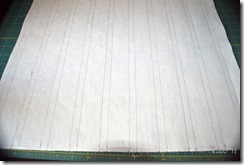
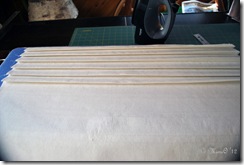
With this disaster in the making diverted and my sanity restored, I commenced to pleat my flounce. The results will be shown in my next post.
Happy Sewing….

 . Enjoy!!!
. Enjoy!!!


